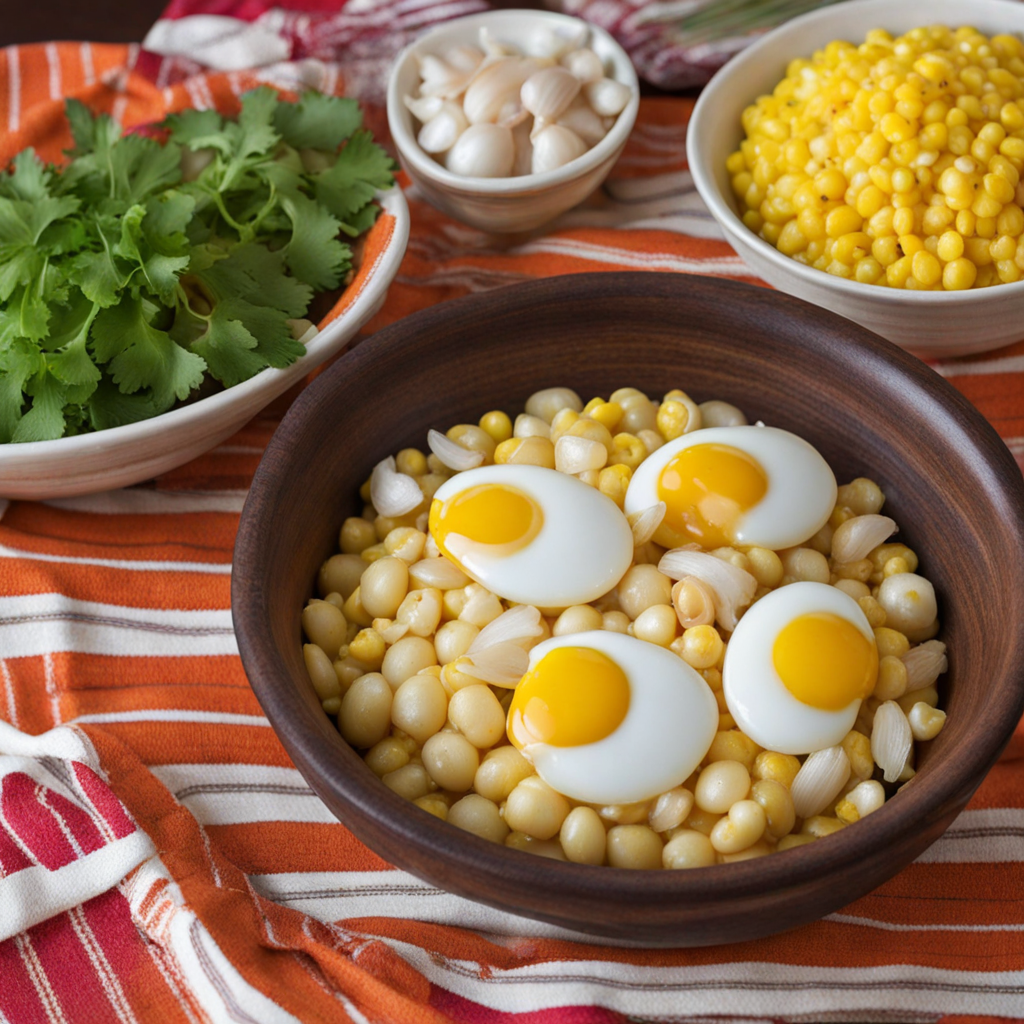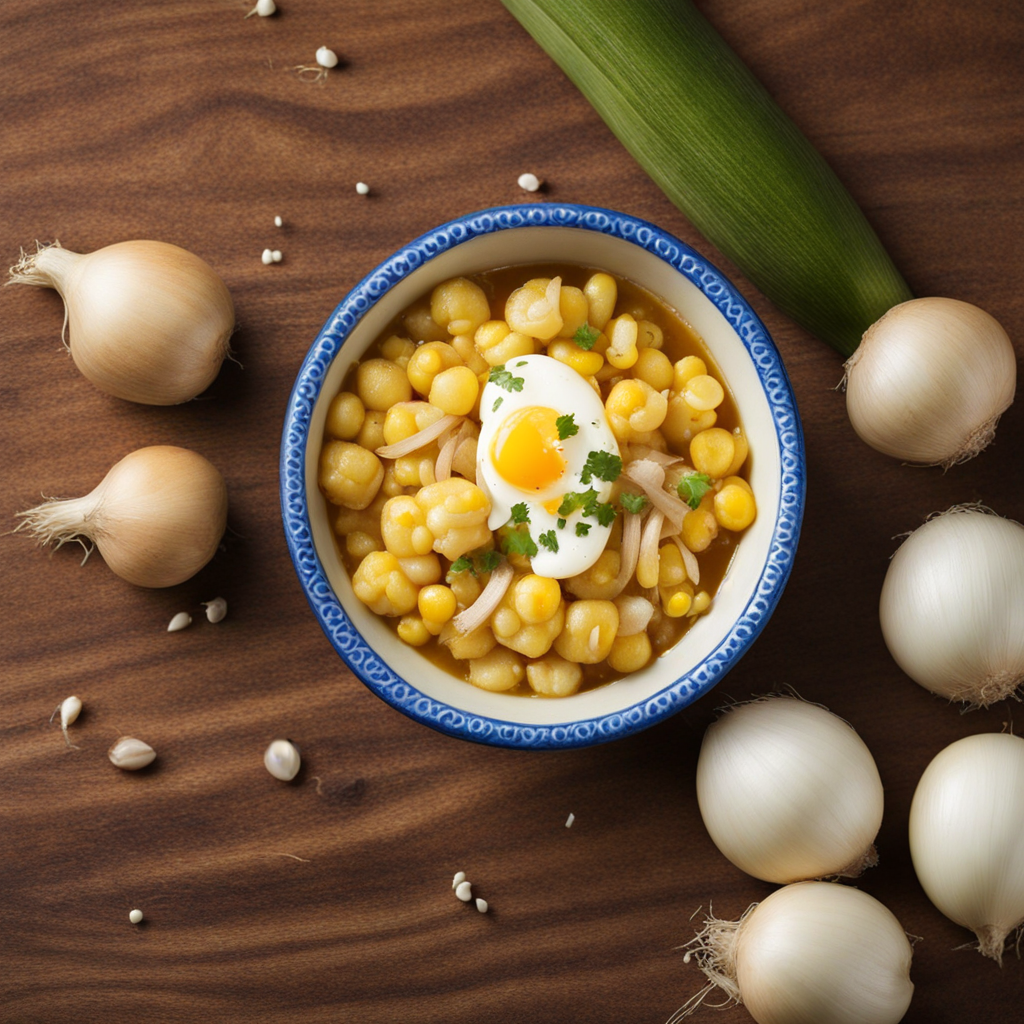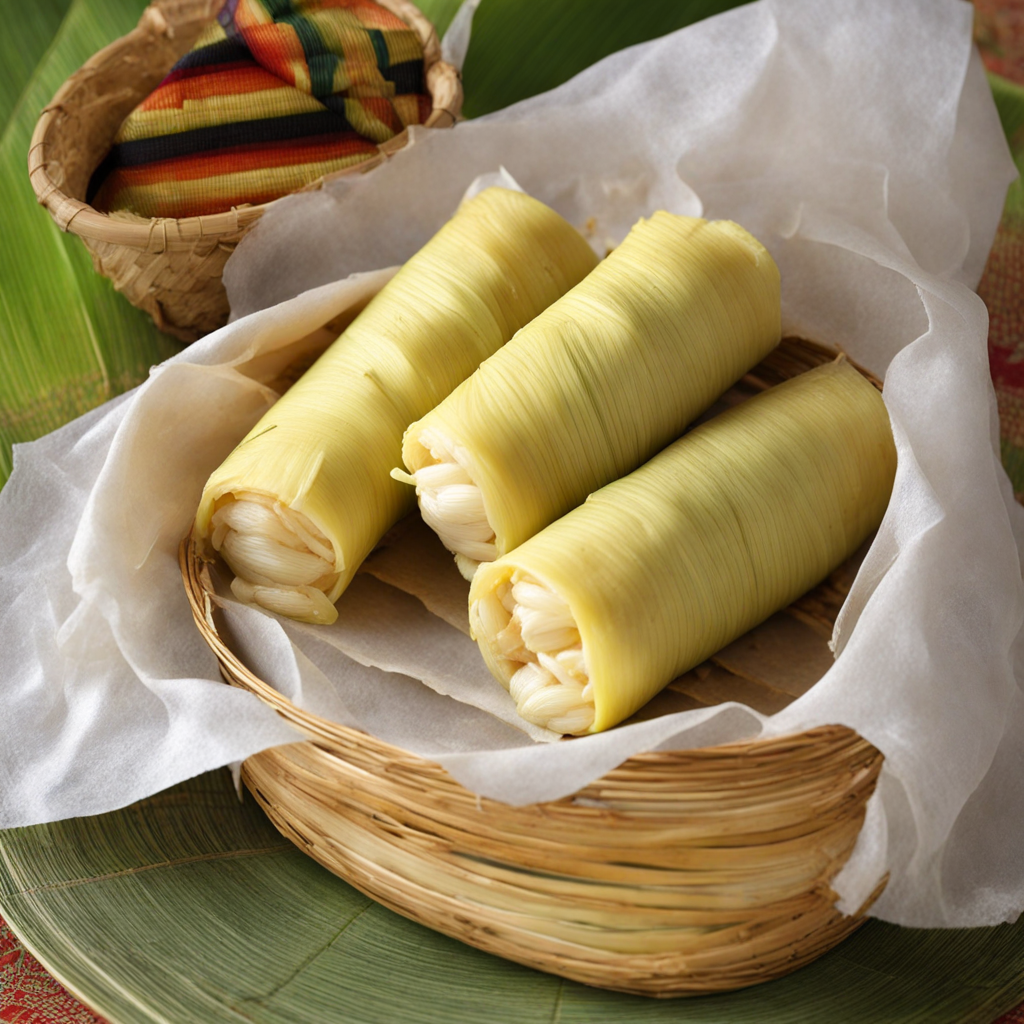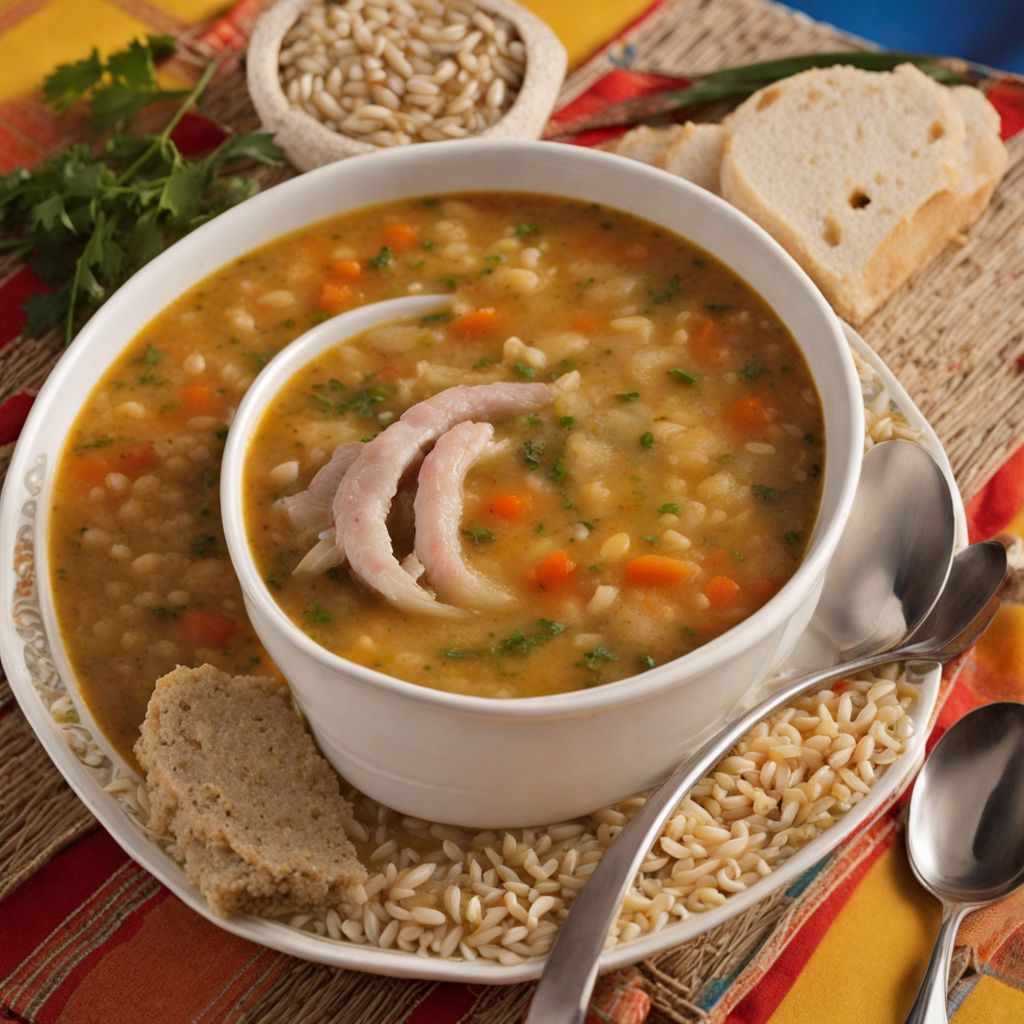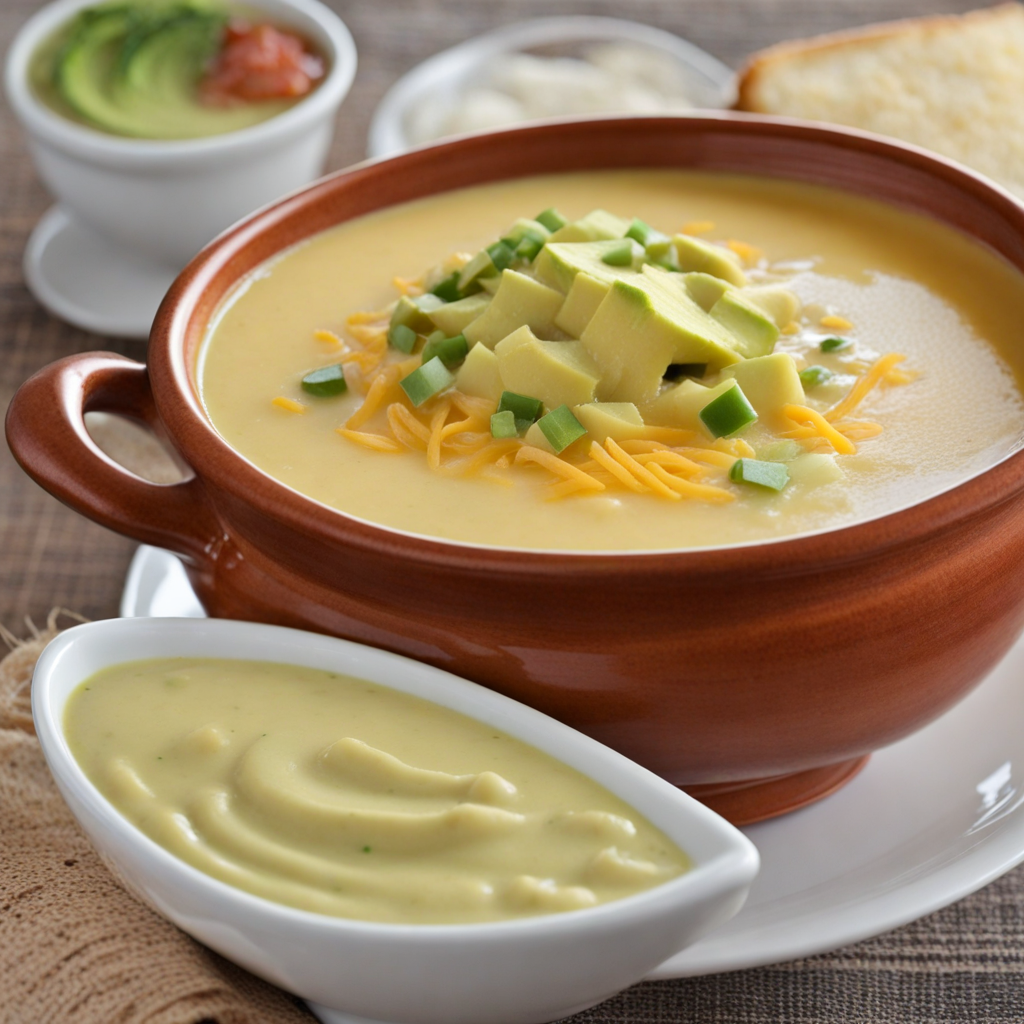Mote Pillo
Mote Pillo is a delightful Ecuadorian dish that beautifully showcases the country's rich culinary heritage. At its core, Mote Pillo features mote, which is a type of hominy or corn that has been soaked and cooked until tender. The dish is often enriched with a blend of sautéed onions, garlic, and spices, creating a fragrant base that perfectly complements the earthy flavor of the corn. The combination is typically seasoned with cumin and achiote, giving it a warm, inviting color and a depth of flavor that is both comforting and vibrant. One of the defining characteristics of Mote Pillo is its versatility. While the basic recipe remains consistent, variations may include the addition of eggs, often scrambled into the mixture, which adds a creamy texture and protein to the dish. Additionally, some recipes incorporate peas or bell peppers, providing a delightful pop of color and freshness. This adaptability allows Mote Pillo to be enjoyed as a hearty breakfast, a fulfilling lunch, or even as a side dish during dinner, making it a staple in many Ecuadorian households. The experience of savoring Mote Pillo is truly unique, as it embodies the essence of Ecuadorian comfort food. Each bite offers a satisfying chewiness from the mote, combined with the savory notes of the sautéed vegetables and spices. Often served with a side of avocado or a fresh tomato salad, it provides a perfect balance of flavors and textures. For those looking to explore new culinary landscapes, Mote Pillo promises a delicious journey through the heart of Ecuadorian cuisine.
How It Became This Dish
The History of Mote Pillo: A Culinary Treasure of Ecuador Mote Pillo is a cherished dish from Ecuador, particularly known in the Andean regions, which showcases the country's rich agricultural heritage and cultural diversity. This dish, a delightful combination of mote (hominy or boiled corn) and a variety of seasonings, encapsulates the essence of Ecuadorian cuisine, reflecting its indigenous roots while evolving through centuries of cultural exchange. #### Origins: The Ancestral Connection The story of Mote Pillo begins with the ancient civilizations of the Andes, particularly the Incas. Corn, or maize, has been a staple food in this region for millennia, revered for its versatility and nutritional value. The Incas cultivated various types of corn, and it became a fundamental part of their diet, used in everything from beverages to stews. The process of nixtamalization, where corn is soaked and cooked in an alkaline solution, was employed to enhance its nutritional content and flavor. This practice laid the groundwork for dishes like mote, which is essentially corn that has been processed in a similar manner. The indigenous peoples of Ecuador have long incorporated mote into their diet, often served alongside meats, vegetables, or in soups. As the Spanish colonizers arrived in the 16th century, they encountered this vital food source and began to integrate it into their own culinary practices. However, Mote Pillo as we know it today—combining mote with eggs, spices, and often topped with cheese—developed distinctly within the context of Ecuadorian culture. #### Cultural Significance: A Celebration of Community Mote Pillo is much more than just a dish; it is a symbol of Ecuadorian identity and community. Traditionally, it is prepared during family gatherings, festivals, and celebrations, reflecting a sense of togetherness and cultural pride. The dish is often associated with special occasions, such as weddings and fiestas, where families come together to share food, stories, and traditions. In many Andean communities, the preparation of Mote Pillo is a communal activity. Families often gather to prepare the ingredients, with older generations passing down recipes and cooking techniques to younger members. This not only strengthens familial bonds but also preserves the culinary heritage of the region. The dish serves as a reminder of the interconnectedness of the community, where each member plays a role in the preparation and enjoyment of food. As a dish rooted in indigenous traditions, Mote Pillo also carries cultural significance related to Ecuador’s agricultural practices. The cultivation of corn is central to the livelihoods of many rural communities, and the dish embodies the principles of sustainability and respect for the land. It is often made with locally sourced ingredients, demonstrating a deep connection to the earth and the seasons. #### Development Over Time: From Tradition to Modernity Over the centuries, Mote Pillo has evolved, adapting to changing tastes and culinary influences. While its foundational elements have remained consistent, variations of the dish have emerged, reflecting regional ingredients and cooking methods. In coastal regions, for example, the dish may incorporate seafood or be served with a side of avocado and fresh salsa, highlighting the rich biodiversity of Ecuador’s coastal areas. In contrast, highland versions may include potatoes or other native tubers, showcasing the agricultural bounty of the Andes. Modern chefs and home cooks alike have embraced Mote Pillo, often experimenting with new flavors and presentations while retaining its traditional essence. Today, you might find Mote Pillo served in upscale restaurants, where chefs elevate the dish with gourmet ingredients or innovative cooking techniques. This evolution is part of a broader trend in Ecuadorian cuisine, where traditional dishes are reimagined to appeal to contemporary palates while honoring their historical roots. The rise of tourism in Ecuador has also played a role in popularizing Mote Pillo beyond its local origins. As visitors flock to the country to experience its rich culture and stunning landscapes, they are introduced to traditional dishes, including Mote Pillo. This exposure has sparked greater interest in Ecuadorian cuisine, leading to a resurgence of interest in traditional cooking methods and ingredients. #### Nutritional Aspects and Modern Variations In addition to its cultural significance, Mote Pillo offers nutritional benefits. The dish is rich in carbohydrates from the corn, and when prepared with eggs, it provides a good source of protein. Vegetables and herbs often added to the dish contribute vitamins and minerals, making it a well-rounded meal. With an increasing awareness of health and wellness, modern variations of Mote Pillo may include substitutions or enhancements to cater to dietary preferences. For instance, some cooks use quinoa as a base instead of traditional mote, capitalizing on its high protein content and health benefits. Others might incorporate organic or heirloom varieties of corn, further emphasizing the trend towards local, sustainable sourcing. #### The Future of Mote Pillo As Ecuador continues to navigate the complexities of globalization and cultural exchange, Mote Pillo stands as a testament to the country’s rich culinary heritage. Its enduring appeal lies in its ability to adapt while remaining rooted in tradition. As Ecuadorians celebrate their cultural identity through food, Mote Pillo will undoubtedly continue to play a vital role in family gatherings and community events. The dish is not only a reflection of the past but also a bridge to the future, where the younger generation will carry forward the recipes and stories that make Mote Pillo an integral part of Ecuadorian culture. In conclusion, Mote Pillo is more than just a dish; it is a vibrant tapestry woven from the threads of history, culture, and community. Its origins in ancient agricultural practices, its significance in celebrating familial ties, and its evolution in modern cuisine all contribute to its status as a beloved culinary treasure of Ecuador. As the world takes notice of Ecuador’s diverse gastronomic landscape, Mote Pillo will undoubtedly shine as a symbol of the country's rich heritage and culinary innovation.
You may like
Discover local flavors from Ecuador


